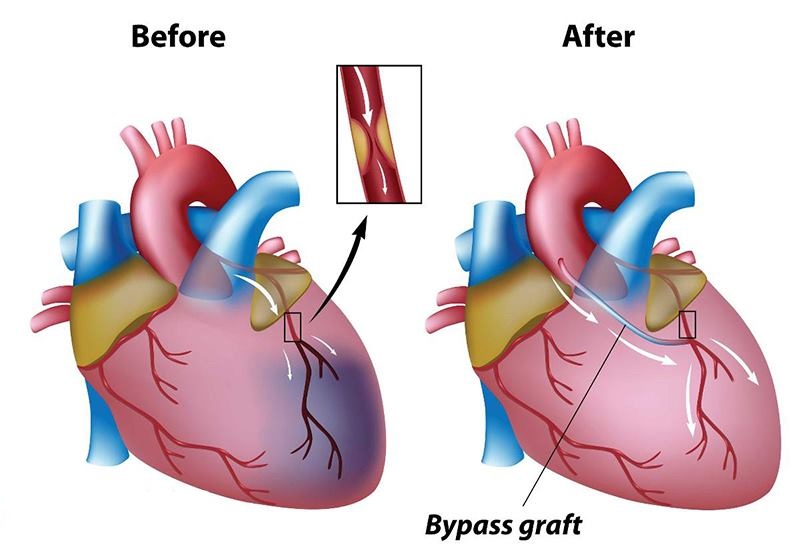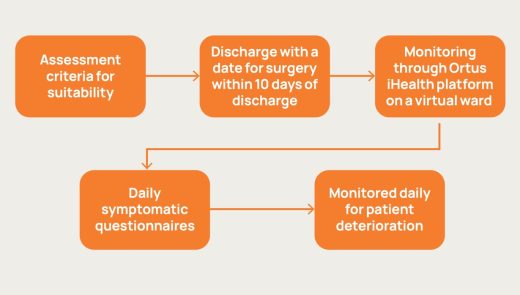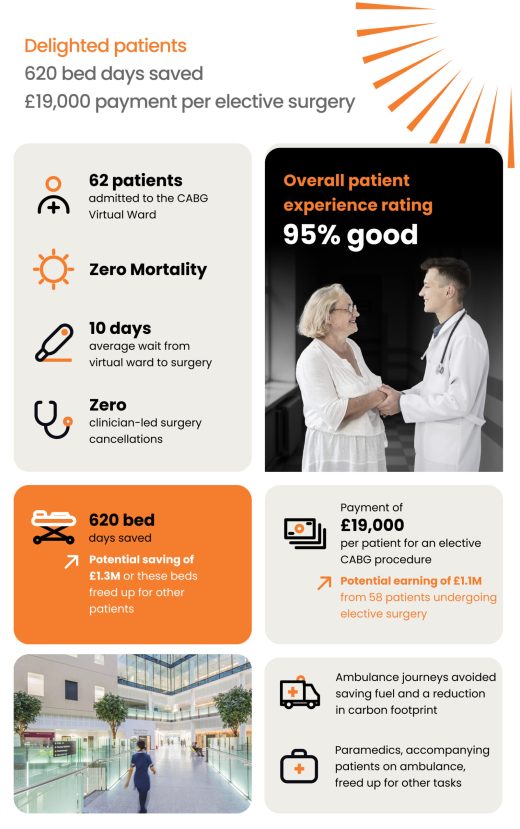Coronary Artery Bypass Graft (CABG) Surgery Virtual Ward
Summary
- 20% of patients can be safely monitored in a virtual ward
- Hospital beds freed up
- Urgent non-elective surgery converted to elective CABG surgery
- Payment of £19,000 per patient for elective CABG surgery
- Zero clinician-led cancellations
- High patient satisfaction

The Problems
Across NHS England the average inpatient bed days wait for CABG is rising. At Barts Heart Centre this was rising to 10-12 days.
This rise is caused by several factors including increasing demand from a growing, ageing population and changes in NICE guidelines for coronary artery urgent surgery referrals versus a reduction in health service capacity caused by factors such as industrial action by nurses and doctors, staff burnout, staff shortages etc.
The knock-on effects of these lengthening inpatient stays include an increased risk of death due to Myocardial Infarction (MI). In addition, patients are at an increased risk of acquired hospital infection and other complications.
For Barts Heart Centre and referring hospitals, such patients occupy many bed days whilst waiting. This disrupts patient flow, creates capacity problems and is an inefficient and expensive use of increasingly stretched healthcare resources.
The Goals
- Reduce inpatient bed days wait
- Improve patient flow and surgery capacity
- Increase ratio of elective to non-elective surgery
The Ortus Solution
CABG Virtual Ward Converts Urgent Non-Elective to Elective Cardiac Surgery
Approximately 20% of patients waiting for urgent cardiac surgery meet the criteria to be safely managed at home on the CABG virtual ward.
These patients transition from urgent non-elective cardiac surgery to elective cardiac surgery and await their procedure at home rather than as inpatients.
Ortus-iHealth remote monitoring platform provides Barts Heart Centre clinicians with a digital platform to remotely monitor patients, communicate, schedule appointments, manage consent and deliver patient education and information. Patients use the Ortus-iHealth app on their smartphones to respond to questionnaires and submit vital signs which are monitored by clinicians.
Data received daily from patient questionnaires and remote monitoring of patient vital signs is evaluated by clinicians through the Ortus-iHealth dashboard. This enables clinicians to accurately determine the severity of a patient’s condition and the appropriateness of the upcoming procedure, aiding in the clinical decision-making process. Patients may be provided with additional monitoring or treated for outstanding health problems before the day of the CABG procedure.
Ortus-iHealth platform has been developed by cardiologists for cardiologists. Key features include:
Scalable virtual ward management: A single clinician can instantaneously view the symptom status of all the patients on a virtual ward from the dashboard and drill down to the details of each patient as required.
Visualised Patient Data: Patient data is presented to the clinician in an easy-to-interpret graphical form showing the progression of symptoms over time. This aids in rapid clinical assessment and decision-making.
Patient Prioritisation: Patient data presented in the dashboard is prioritised according to thresholds that are set by clinicians. Patients breaching thresholds are presented at the top of the list and can be managed as a priority.
Efficient Patient Communication: A single message can be simultaneously sent to many recipients via the patient app freeing up valuable time for the clinician to follow-up one-on-one with patients needing immediate attention.
Clinician configuration: Patient questionnaires, Patient Reported Outcome Measures (PROMs,) messaging templates etc. can be configured according to the needs of the team by clinicians seamlessly integrating into existing cardiology service procedures and practices
The Results
The Results:
- 20% of patients can be safely managed at home on the virtual ward
- 620 hospital bed days freed up
- Increased ratio of elective to non-elective surgery
- Payment of £19,000 per patient for elective surgery
- High patient satisfaction
- Zero clinician-led surgery cancellations
The Pathway

- Assessment of patient eligibility for safe discharge to the virtual ward is made jointly by the cardiologist and cardiac surgeon based on their analysis of the patient’s angiogram, ECG, medical history etc.
- Patients, instead of remaining in hospital awaiting the procedure, are discharged from the hospital to home, given a date for surgery that will be within 10 days of discharge and their named cardiac surgeon who will perform the procedure.
- Patients are admitted (onboarded) into the CABG virtual ward and monitored by the Ortus-iHealth remote patient monitoring platform. Before returning home an Advance Nurse Practitioner (ANP) guides the patient on how to use the Ortus-iHealth patient app.
- Via the app, patients can submit responses to daily symptom questionnaires and vital sign measurements.
- Symptoms and vital signs are monitored daily by the ANP for any deterioration.


